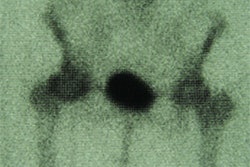SAN FRANCISCO - Radiology residents who pull after-hours duty in the emergency department are obviously required to think fast and offer quick interpretations, but how good are they at making these decisions -- particularly when it comes to a life-threatening condition such as pulmonary emboli (PE)?
Dr. Yair Safriel, a resident at the State University of New York Downstate in Brooklyn tackled that question in a presentation at the American Society for Emergency Radiology meeting on Thursday. Safriel's group conducted a retrospective study of CT pulmonary angiograms (CTPA) and the success rate of residents in identifying PE.
"In New York City, of the five major hospitals affiliated with medical schools, none have 24-hour attending [radiologist] coverage. That means that residents are reading these scans, and it can have potentially deadly results on the patients," Safriel said.
This study involved 25 consecutive CTPA exams, with nine referred from the intensive care unit and seven from the ER. The overall rate of PE was 44%, Safriel said.
Two attending radiologists and four residents, including one first-year, reviewed the scans. "That’s important because the first-year was interpreting routine pulmonary angiograms soon after he started on-call," Safriel said.
Each CTPA was divided into 28 arterial zones based on pulmonary anatomy, for a total of 700 arterial zones. The presence of pulmonary emboli was rated as high, intermediate, low probability, or not visualized.
For the kappa analysis, the zones were assigned to three regions: Region 1 was the main pulmonary artery; Region 2 was the left lower lobe; and Region 3 was made up of the subsegmental arteries.
"We wanted to approximate the clinical setting as much as possible," Safriel said. "At our institution, residents at night give a preliminary report, and the attending will come in the morning for the final verdict. There should not be a significant difference between the preliminary report and the final interpretation."
According to the results, interobserver agreement was good in Region 1, or the main pulmonary artery (K=0.61) and fair in the segmental arteries (Region 2; K=0.26). In Region 3, interobserver agreement was poor (K=0.16), Safriel said. Interobserver agreement was greatest (K >0.4) in the left main, left lower lobe, and right main pulmonary arteries, he added.
Safriel concluded that residents and attending radiologists could come to similar conclusions regarding central pulmonary emboli. Although there was greater disagreement in the subsegmental arteries, residents are capable of accurately assessing patients for PE in an emergency setting, he said.
One session attendee pointed out that the results would have been different, and possibly more meaningful, if the two attending radiologists had specialized in chest trauma.
"Not all attendings are created equal and not all residents are created equal," the attendee said. "If these were chest attendings, you’d have had a different set of results, just as if you’ve got a first-year or a senior resident, you’d expect different results."
By Shalmali PalAuntMinnie.com staff writer
March 16, 2001
Related Reading
Study claims that ER doctors are too cavalier about ordering V/Q scans, November 28, 2000
Click here to post your comments about this story in our Residents Digital Community. Please include the headline of the article in your message.
Pass on the Rolaids: CT scans for appendicitis stump radiologists, May 11, 2000
Copyright © 2001 AuntMinnie.com




















